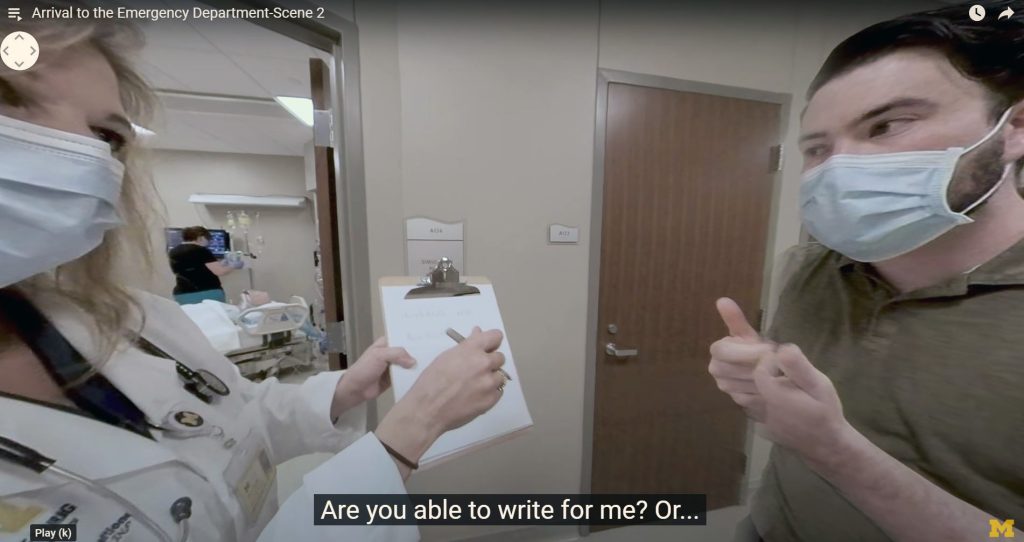Virtual Reality in Healthcare Education is not the future anymore, it’s the present! Michelle Aebersold tells us how she is using immersive VR simulation to provide realistic and safe learning environments to improve preparation for real-world nursing challenges and veteran care
Welcome to the future of simulation-based learning
Since the ’90s, healthcare education has had quite a digital facelift. And now, we’re ushering in a new age, harnessing the latest technological innovations to redefine healthcare education and training by using the latest simulation technologies, Extended Reality (XR). So, what is XR? The XR Safety Initiative (XRSI) recently created a taxonomy to define varied technological terms. Extended Reality (XR) is the overarching term for all types of alternate realities, encompassing Virtual Reality (VR), Augmented Reality (AR), and Mixed Reality (MR) technologies. VR simulation offers a fully digital, immersive environment experienced through special equipment like head-mounted-displays. 360 Video, another immersive format, records views from all directions viewable on a computer or similar devices. This technology is ever changing so what we know today will advance.
Why Virtual Reality in Healthcare Education?
With VR, we can put our learners into a realistic clinical experience loaded with all the complexities of real-world healthcare. It’s fantastic, because unlike many simulation setups, these VR environments offer a controlled environment for the learners to try their hand at things like prioritization, decision making, delegation, and more. They can practice being the healthcare provider in a true to life role, without putting patients at risk.
What is Happening in the world of Immersive Virtual Reality?
As an early innovator and adopter of technology driven learning at the University of Michigan School of Nursing, I have been lucky to be involved with a great team of people to develop interesting VR applications. Our team has been using 360-degree videos to get a better grasp on how we can better care for the deaf or hard of hearing, and our military veterans. If you watch these videos, you’d see these mini dramas showing interactions between nurses and patients which reveal the specifics of their care needs. In one video, you see a nurse trying to communicate with a deaf family member who uses American Sign Language (ASL) in a trauma bay after a car accident. It’s a bit of a frustrating scene as they struggle to talk without a qualified medical interpreter until finally, a Video Remote Interpreting (VRI) service comes into play making communication smoother!

In another set of videos, we dive into caring for Military Veterans. These 360-degree videos feature scenes of nurses and veterans interacting positively, and these clips brilliantly showcase their unique care needs and efficient ways to assist and support them.
Although this was developed in the United States the needs of the Veterans are universal and relevant to many countries. The cool thing about the videos is they can be viewed through YouTube VR for free.
This can be done on a phone/tablet or using a VR headset.
And then there’s this cool VR simulation, “Under the Skin“, that we’re using to better understand oncology emergencies.

Using an experiential approach, learners are introduced to two patients undergoing chemotherapy where there’s a possibility of serious tissue injury if the medication leaks out of the blood vessel (extravasation). This VR program is part of our efforts to ensure safer chemotherapy administration. Learners can practice protective gear usage, responding to an extravasation event, and they even get to see the cellular effects of the drug on the human body. The immersive nature of this experience helps learners understand the urgency to treat a medication leak quickly to prevent damage. This program is available for free to download on the Meta App Lab.
What is Next on the Horizon of Healthcare Education?
The current project I am involved with is called “The Big Ten Practice Ready Nursing Initiative”. Led by Dr. Cynthia Bradley at the University of Minnesota we partnered with Oxford Medical Simulation to create a series of single-player, multi-patient scenarios. The goal was to create simulations to teach crucial skills like clinical reasoning, decision making, prioritization, along with interpersonal skills, such as communication and collaboration. So, what’s the word on the ground? Early tests of these multi-patient VR scenarios at three nursing programs hinted at their potential and were well-received by students. The use of robust simulation strategies based on the Healthcare Simulation Standards of Best PracticeTM, has created a safe and positive learning experience. VR can be an amazing and engaging form of simulation that can be easily used by all simulationists and will truly benefit our learners
READ ALSO































